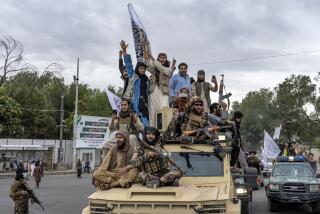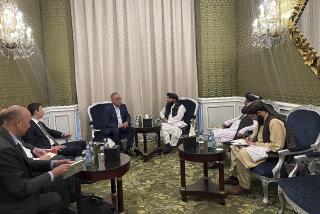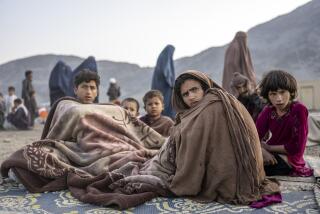Afghans explore idea of post-Taliban council
A procession of large turbaned men with grim visages, thick beards and dusty robes has passed through Hamid Karzai’s gate in this southwestern Pakistani city for the last few weeks.
The visitors identify themselves as tribal leaders and former commanders under the Taliban who have had enough of the mullahs who have ruled their homeland for the last five years. Since the terrorist attacks on the United States, they have been secretly traveling to Pakistan to help forge a new, broad-based, representative government to replace the regime.
Karzai is actively recruiting these ethnic Pushtun fighters, seeking their support for the convening of a traditional loya jirga, or grand council, of Afghans under the aegis of 86-year-old Mohammad Zaher Shah, the monarch who was deposed in 1973.
From the United Nations to Washington, to the ex-king’s residence outside Rome and the opposition in northern Afghanistan -- and now even in Islamabad, the capital of neighboring Pakistan -- a consensus has been forming since Sept. 11 that a loya jirga offers the best chance to resuscitate the failed state, allow it to be rebuilt and bring it back into the international community.
However, carrying out the plan is proving difficult. Now that U.S. military action has begun, it is unclear how long the opposition Northern Alliance will agree to postpone an assault on the capital, Kabul, to give time for a broader post-Taliban government to solidify.
The Taliban resistance already shows signs of crumbling in some places, and Northern Alliance generals now say they want to attack on all fronts within a week or two.
Could the loya jirga plan be put into motion that quickly? Timing is only one of several serious questions about the plan. Others include:
Would it be accepted as legitimate by the Afghan people or seen as imposed from the outside?
Would it be sufficiently democratic and fairly reflect Afghanistan’s tribal, ethnic and sectarian makeup and give at least a voice to the now-silenced female majority?
Would the bitter rivalries, ingrained factionalism and foreign interference that have kept Afghans at war with one another since Soviet occupiers were repelled in 1989 melt away?
- Would a new government be doomed at birth, plunged into a debilitating conflict with the remnants of the Taliban and a generation brought up ignorant of tribal traditions but steeped in Osama bin Laden’s brand of militant Islam?
Recruitment of Pushtun supporters
At Karzai’s house, and at similar gatherings in Peshawar, to the northeast, advocates of the loya jirga are recruiting ethnic Pushtun fighters who make up the Taliban’s base to ensure that whatever government emerged would be widely seen as legitimate.
Another key element is Pakistan, which despite its denials gave the Taliban crucial support as the fundamentalists seized control of Afghanistan from 1994 to 1996. At that time, Pakistan hoped for stability and a friendly regime to its west. Now, President Pervez Musharraf said Monday, the national interest dictates a change of course.
Musharraf said Pakistan is seeking a new “dispensation” for Afghanistan. He spelled out the requirements -- that it be democratic, authentic, ethnically balanced and not hostile to Islamabad.
All the signs are that Pakistan has signed on to the loya jirga plan and will hold talks with representatives of the ex-king, who reigned for 40 years.
Without agreeing to reveal the names of likely defectors, Karzai, an Afghan deputy foreign minister in the mid-1990s and the former king’s man in Quetta, says there is a “clearly sufficient” groundswell of opposition to the Taliban -- whose medieval rule, failure to rebuild the Afghan economy and harboring of militants like Bin Laden have alienated many supporters.
A weekend visit to Karzai’s home revealed the host seated on a carpet in a large reception room lined with about 20 august personages from Afghanistan, all talking loya jirga. In a second room were about 25 more visitors waiting their turn -- battle-scarred veterans, most having just come from such cities as Kandahar, Herat and Kabul.
Perhaps a dozen other visitors milled about the house, where the phones and fax machines were busy too. Karzai described an operation to spread information about the plan for a loya jirga and to woo potential supporters.
Most of those in favor of a council argue that it should be convened on Afghan territory in the near future, perhaps as soon as U.S. military attacks or advances by the opposition Northern Alliance create a secure zone cleansed of Taliban soldiers. Kabul would be ideal, Karzai says, but any city would do. Karzai does not rule out the idea that some elements of the Taliban could join the deliberations.
“The ones who have really sided with terrorism cannot be considered for the new arrangements,” he said. “But the majority, the common Taliban, the ordinary Talib with a gun, he is simply an Afghan man.”
In contrast to the rhetoric of Taliban leader Mullah Mohammed Omar and his defenders in Pakistan, visitors to Karzai’s home spoke as though support for the regime is steadily vanishing. Mullach Abdul Mannem, 48, a veteran commander and the regal-looking leader of a village outside Kandahar, said his community of about 5,000 is ready to defect en masse.
Karzai says a decisive majority of Afghans, given the choice, would favor holding a loya jirga, because the institution has been used to unite tribes and legitimize new rulers for more than 200 years.
The Northern Alliance, made up mostly of ethnic Tajiks and Uzbeks, has been battling the mainly Pushtun Taliban for years, giving the conflict an ethnic edge. Now, with the U.S. and much of the world behind them, some alliance members are intoxicated by the possibility that they could recapture Kabul soon.
But to Pakistan and many Pushtuns, the Northern Alliance alone is unacceptable as a successor to the Taliban on a number of counts: its ties to India, Russia and Iran; its questionable human rights record (including allegations of torture, rape, mass executions and “ethnic cleansing”); and its domination by smaller ethnic minorities rather than Pushtuns, the largest Afghan ethnic group.
Many experts question whether the alliance could govern.
“Pushtuns have to be an important part. Not the dominant part, but part of a government that represents all minorities,” a U.S. diplomat said.
In what could prove a historic agreement, the alliance and the backers of the former king, who is also Pushtun, agreed Oct. 2 to join in forming a broad-based government. Each side is to nominate representatives to a 120-member Supreme Council for National Unity that would gather in Rome before Nov. 1. The council would then try to convene the loya jirga, with a mandate to form a two-year provisional government.
There was an agreement, according to Yusuf Nuristani, a spokesman for the ex-king, that the Northern Alliance forces would not capture Kabul and claim it, but would wait to give the supreme council a chance to form and meet.
However, an Italian diplomat closely involved in the process warned that the understanding could unravel unless the southern Pushtun opposition gets going soon. The Italians worry that the U.S. airstrikes weakening the Taliban may spur the Northern Alliance to drive toward Kabul alone.
The dilemma for the U.S. is how to support the loya jirga idea while keeping its distance. Everyone agrees that a council instigated by the U.S. would be seen by most Afghans as a puppet gathering. Although the plan has been quietly encouraged by the administration, President Bush has stated for the record: “We’re not into nation-building.” But he suggested Thursday that the United Nations might play a role in setting up a post-Taliban government.
Zaher Shah’s people agree. “To bring about a future leadership in Afghanistan is the sole responsibility of the Afghan people,” said Abdul Sattar Sirat, a royal aide.
But “how democratic can any appointed council be?” asked Dr. Sima Samar, an ethnic Hazara from central Afghanistan who now lives in Quetta. Samar is skeptical that women or Hazaras -- Shiite Muslims who trace their ancestry to Genghis Khan’s troops -- would be accorded their due weight in a traditional council. She would prefer early democratic elections.
Questions about president’s future
Another potential stumbling block to a loya jirga is whether President Burhanuddin Rabbani of the Northern Alliance, who led the toppled government still recognized by the most of the world, would angle to stay in power.
“He has no choice but to resign” if the council chooses someone else, said royal aide Hedayat Amin Arsala.
The ex-king’s role remains ambiguous. Zaher Shah will turn 87 Sunday, and his age raises questions about how long and how effectively he could serve.
Supporters counter that Zaher Shah is offering himself only as a symbol to bring together a jirga. The council would have the responsibility of writing a new constitution and choosing a government.
The ex-king’s grandson, Mostapha Zaher Shah, said last week that he would not minimize the difficulties ahead but that he sees no other way out for the country.
“It will take the Afghans generations to overcome their differences, but we have to start somewhere,” he said. “If we cannot unite now, when are we going to unite? “It’s a golden opportunity for the Afghan people . . . regardless of ethnicity, regardless of region, regardless of gender, to come together and to save their country from a certain calamity.”
Daniszewski reported from Islamabad and Quetta, Boudreaux from Rome and Tempest from Islamabad. Staff writer Robyn Dixon in northern Afghanistan also contributed to this report.
More to Read
Sign up for Essential California
The most important California stories and recommendations in your inbox every morning.
You may occasionally receive promotional content from the Los Angeles Times.










